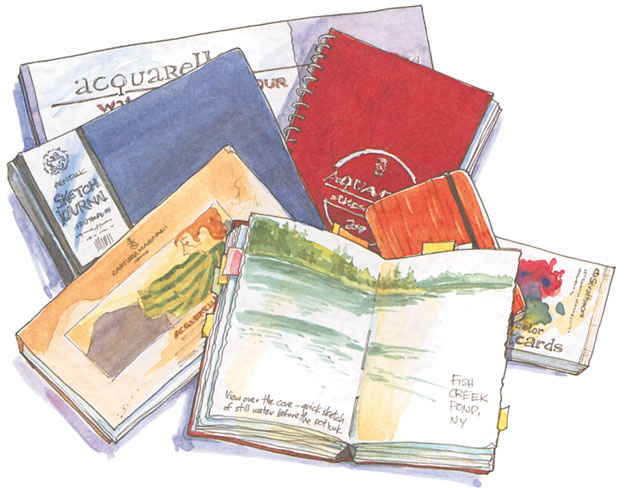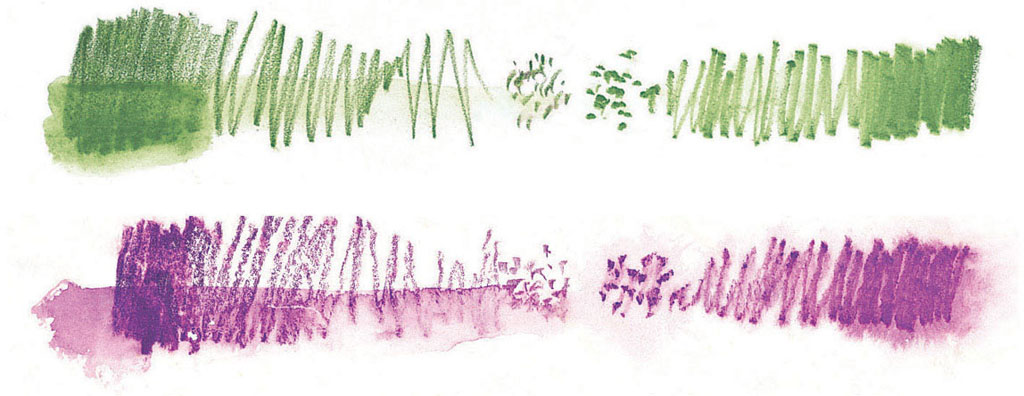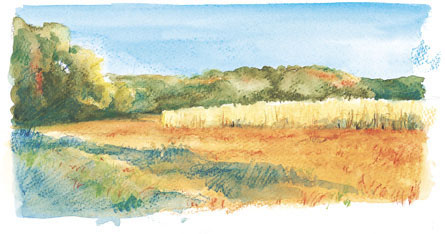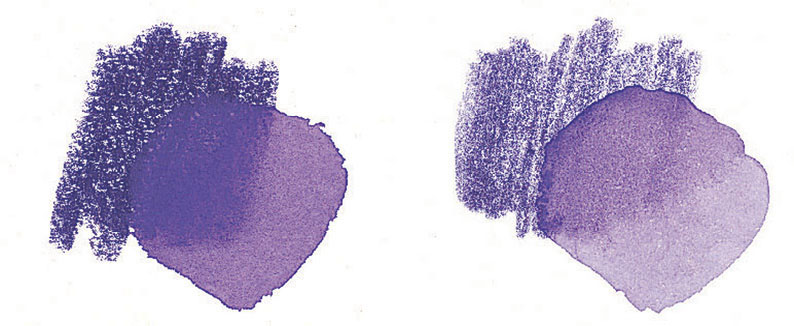
You will need a painting surface that matches your needs. If you are planning a fairly wet application, buy watercolor paper of at least 140-lb. (300gsm) weight, as lighter papers will buckle. If you do use a lightweight paper, either mount it or use a dry-brush technique. Consider the surface of your paper as well. Is it tough and durable or soft and delicate? You will not be happy using one of the more delicate papers.
Another paper option is a good quality sketchbook. I often use a Strathmore bristol drawing pad with a regular surface. Its two-ply paper will withstand wetness without too much buckling. A pad of regular drawing paper will work, too, as will a block of watercolor paper—just don’t get one with a really rough, mechanical surface because it will be hard to draw on.

For working at home, you may want to buy full sheets of watercolor paper (usually 22" × 30" [56cm × 76cm]) and cut them to the size you want. If you get 300-lb. (640gsm) paper, it won’t need to be stretched or taped to a support, but 140-lb. (300gsm) paper is sufficient for most needs. Tape it to a support with masking or drafting tape and you won’t have much buckling. Any small hills and valleys that form will generally flatten back out as the paper dries.
You can also buy pads or watercolor blocks. The latter are comprised of multiple sheets, glued together on all four sides, with a small opening to allow you to insert a blunt blade to free a dry, finished painting. If the paper is 140-lb. (300gsm) or better, there is virtually no buckling with blocks, no matter how wet you paint. Watercolor blocks are great for travel or field work.
There are three common surface textures in watercolor paper: rough, hot press and cold press. Cold press may be the most versatile, but many watercolorists like rough paper for a variety of textural effects. It is more difficult to control your washes on hot-pressed paper, but it can be very exciting, splashy and puddly. Try them all to see which you prefer.
As always, buy a good brand—I like Fabriano, Arches or Strathmore. Inexpensive papers may have a nasty mechanical texture or refuse to take washes well. Some are too absorbent or buckle excessively when wet. Nothing is as discouraging as trying to paint on inferior or student-grade stuff.
For use with watercolor pencils or watercolor techniques involving lifting or scraping, you will be happiest with a tough, hard-surfaced paper. Softer, more delicate papers are best reserved for traditional painting techniques.

A pencil will make a smooth, unbroken line on smooth paper (as shown with the green pencil strokes), while on rougher paper the pencil skips and skitters, making a broken line rather like a linear dry-brush technique (as shown with the violet pencil strokes). If you wet it quickly and lightly, the pencil stroke will retain some of the textured effect.

FIELD PIECE
Graphite and watercolor pencil on Strathmore rough watercolor paper
5" × 91⁄2" (13cm × 24cm)
Here, there are dots and dashes of texture in the shadows on the lower left. They are left over from the original pencil tone. I used a light touch to blend that area. When adding water to the sky, I wanted to achieve a smoother effect so I blended more aggressively with my brush. Of course, non-soluble pencils keep their texture regardless of the amount of water applied.

NEVADA RUNOFF
Watercolor pencil on Strathmore Imperial cold-press watercolor paper
73⁄4" × 51⁄2" (20cm × 14cm)
I had planned this piece as an example of saturated color and just used the top sheet in a Strathmore paper sampler. It turned out to be a very soft-surfaced paper, fine for traditional watercolor but not at all suited for pencil work. In order to get a good strong shade the first try, you would normally apply your watercolor pencil heavily, with a great deal of vigor. But because of the fragility of the paper, I was forced to apply the color in four or five layers in order to get the intensity I was after.
Here are two squiggles of color to demonstrate the differences in paper. The one on the left is on a softer surface, while the one on the right is on a paper with a lot of sizing, so it will take rough handling. The more delicate paper would be perfectly acceptable with traditional watercolor, but it would not be the proper choice for bold pencil work.
